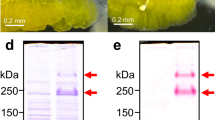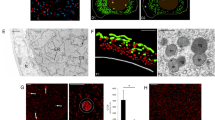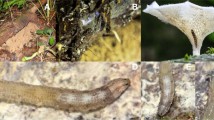Abstract
SYMBIONTS of Glossina previously described by Wigglesworth1 as Gram-negative intracellular bacteroids are located in a group of specialised cells, the mycetome, in the midgut. Their intracellular nature is well known from studies with the light1–3 and electron4 microscopes (see Fig. 4). Roubaud3 demonstrated bacteroids in the mycetome of the larval midgut of G. palpalis. He was unable to determine the mode of transmission, but suspected the involvement of the milk gland, as have other authors5,6. Recent work on the ultra-structure of the milk gland has demonstrated that bacteroids occur extracellularly in the lumen of the gland7, thus adding support to the notion that transmission from one generation to the next may occur through the secretions of the milk gland. Bacteroids have not, however, been located in the cells of the milk gland, and it remains uncertain whether this route of transmission is used.
This is a preview of subscription content, access via your institution
Access options
Subscribe to this journal
Receive 51 print issues and online access
$199.00 per year
only $3.90 per issue
Buy this article
- Purchase on Springer Link
- Instant access to full article PDF
Prices may be subject to local taxes which are calculated during checkout
Similar content being viewed by others
References
Wigglesworth, V. B., Parasitology, 21, 288 (1929).
Stuhlmann, F., Arb. Kaiserl. Gesundh., 26, 301 (1907).
Roubaud, E., Ann. Inst. Pasteur, 33, 489 (1919).
Reinhardt, C., Steiger, R., and Hecker, H., Acta trop., 29, 280 (1972).
Buxton, P. A., The natural history of tsetse flies (Lewis, London, 1955).
Buchner, P., Endosymbiosis of animals with plant microorganisms (Wiley, New York, 1965).
Ma, W.-C., and Denlinger, D. L., Nature, 247, 301 (1974).
Tobe, S. S., and Davey, K. G., Can. J. Zool., 49, 577 (1971).
Huebner, E., and Anderson, E., J. Morph., 136, 459 (1972).
Anderson, W. A., and Ellis, R. A., J. Protozool., 12, 483 (1965).
Glauert, A. M., and Thornley, M. J., A. Rev. Microbiol., 23, 159 (1969).
Moloo, S. M., Acta trop., 28, 334 (1971).
Odhiambo, T. R., Experientia, 24, 738 (1968).
Odhiambo, T. R., J. exp. Zool., 177, 447 (1971).
Peleg, B., and Norris, D. M., Nature new Biol., 236, 111 (1972).
Author information
Authors and Affiliations
Rights and permissions
About this article
Cite this article
HUEBNER, E., DAVEY, K. Bacteroids in the ovaries of a tsetse fly. Nature 249, 260–261 (1974). https://doi.org/10.1038/249260a0
Received:
Issue Date:
DOI: https://doi.org/10.1038/249260a0
This article is cited by
-
Subcellular degeneration of mycetomal endocytobionts in tsetse,Glossina morsitans morsitans, inoculated twice withEscherichia coli
Current Microbiology (1989)
-
Symbionts in the female tsetse flyGlossina morsitans morsitans
Experientia (1975)
Comments
By submitting a comment you agree to abide by our Terms and Community Guidelines. If you find something abusive or that does not comply with our terms or guidelines please flag it as inappropriate.



